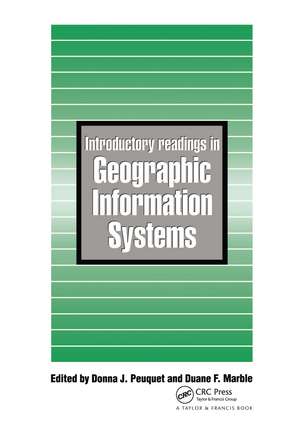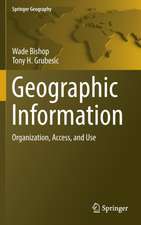Introductory Readings In Geographic Information Systems
Editat de D J Peuquet, D F Marbleen Limba Engleză Paperback – 19 sep 1990
Preț: 416.87 lei
Preț vechi: 533.55 lei
-22% Nou
Puncte Express: 625
Preț estimativ în valută:
79.77€ • 83.67$ • 66.41£
79.77€ • 83.67$ • 66.41£
Carte tipărită la comandă
Livrare economică 01-15 aprilie
Preluare comenzi: 021 569.72.76
Specificații
ISBN-13: 9780850668575
ISBN-10: 0850668573
Pagini: 382
Dimensiuni: 178 x 254 x 21 mm
Greutate: 0.79 kg
Ediția:1
Editura: CRC Press
Colecția CRC Press
ISBN-10: 0850668573
Pagini: 382
Dimensiuni: 178 x 254 x 21 mm
Greutate: 0.79 kg
Ediția:1
Editura: CRC Press
Colecția CRC Press
Public țintă
UndergraduateCuprins
Part 1 What is a geographic information system?: geographical information systems - an overview, Duane F.Marble; geographical information systems - a new frontier, Roger F.Tomlinson; a classification of software components commonly used in geographical information systems, Jack Dangermond; GIS versus CAD versus DBMS - what are the differences?, David J. Cowen. Part 2 Examples of practical applications: MAGI - a state-level grid cell system, State of Maryland; ARC/INFO - a modern GIS, Environmental Systems Research Institute; technical description of the DIME system, US Bureau of the Census; prinicpal components of the census bureau's TIGER file, Joel Sobel; the Tiger system - automating the geographical structure of the United States, Robert W.Marx; current and potential uses of geographical information systems - the north American experience, Roger F.Tomlinson; an experiment in land-use allocation with a geographical information system, C.Dana Tomlin and Kevin M.Johnston; Integration Of Geological Datasets For Gold Exploration In Nova Scotia, G.F.Bonham-Carter, F.P.Agterberg and D.F.Wright; modeling community vulnerability to hazardous materials using geographical information systems, Robert B.McMaster; representing and applying knowledge about spatial processes in environmental management, J.R.Davis, P.Whingham, and I.W.Grant. Part 3 Operations and problems of building a database: creating large digital files from mapped data, Hugh W.Calkins; manual digitizing systems, E.Alan Cameron; interaction between the cartographic document and the digitizing process, Donna J.Peuquet and A.Raymond Boyle; a review of digital data commonly available and some of the practical problems of entering them into a GIS, Jack Dangermond; efficient digitizing through the combination of appropriate hardware and software for error detection and editing, Nicholas R.Chrisman. Part 4 GIS internals - data representation and analysis techniques: spatial data models - a conceptual framework and comprehensive review, Donna J.Peuquet; historical data as an explicit component of land information systems, Ric Vrana; it makes me so CROSS, David Douglas; the accuracy of map overlays - a reassessment, Nicholas R.Chrisman. Part 5 Design and evaluation of GIS: establishing a geographical information system in relation to its use, a process of strategic choices, W.H.Erik DeMan; a conceptual model of the manual digitizing process, Duane F.Marble, Jean P.Lauzon and Matthew McGranaghan; performance eval and work-load estimation for GIS, Michael Goodchild and Brian R.Rizzo; liability for information, Earl F.Epstein and Howard Roitman.
Notă biografică
D J Peuquet (Edited by) , D F Marble (Edited by)
Descriere
Even though Geographic Information Systems GIS have been available for over 20 years, they have only recently become accessible to geographers and others as a useful tool in spacial analysis. This is a sampling of basic principles of GIS, as well as











